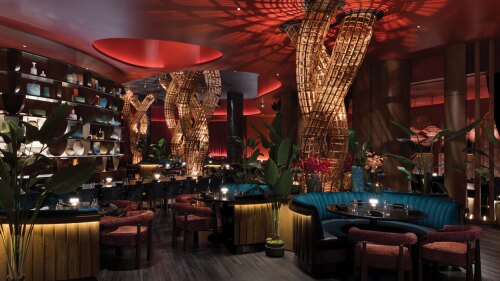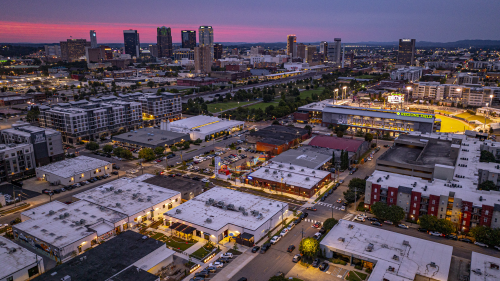Property Types
Hotels and Resorts
The hotel industry in the United States faces complex challenges in 2025, according to Jan Freitag, national director of hospitality analytics for the CoStar Group. During the “State of the U.S. Hotel Industry” presentation at the ULI 2025 Spring Meeting in Denver, Colorado, Freitag highlighted the challenges facing the hotel business amid macroeconomic uncertainty.
Once a sprawling expanse of uncharted land, Las Vegas, Nevada, has evolved into the entertainment capital of the world, a gaming super-hub, and a premier destination for sports. This remarkable transformation didn’t happen overnight; it stemmed from decades of strategic planning, investment, and visionary zoning recommendations.
Las Vegas is unlike any other place in America. Each year it draws more than 40 million visitors to the dazzling casinos and hotels that “turn night into daytime”—and transform the city into a glittering jewel in the desert. With 164,000 hotel rooms, Las Vegas is the largest hospitality market in the U.S.—outpacing Orlando, Florida, the next biggest market, by approximately 15 percent, according to JLL.
Industrial
Standing in the shadow of Regions Field and within earshot of Railroad Park, Birmingham’s Urban Supply hints at what the next chapter of downtown life could look like. Once-quiet brick warehouses are being steadily reimagined into patios, storefronts, and gathering spaces along a new pedestrian alley. Early tenants have begun to open their doors, and programming is slowly bringing people into the district. While the project is still in its early stages, the framework is in place for a vibrant hub that will grow block by block in the years ahead.
What trends are shaping the future of the industrial sector? Four experts from ULI’s Industrial and Office Park Development Council talk about the industrial submarkets and property types that offer the greatest opportunities, challenges developers face in bringing new projects to market, ways artificial intelligence and emerging technologies are reshaping the sector, tenant priorities, and other key trends.
After a quiet first half of 2024, CMBS originations increased 59 percent in Q3 on a year-over-year basis, according to the Mortgage Bankers Association’s Quarterly Survey.
Mixed-Use
By 2050, aging baby boomers are expected to swell the population of Americans 65 and older to 89 million—a surge that will require more than just an increase in the capacity of housing for seniors.
As the health care industry continues to expand, recognition that its host environments become or remain vital is increasingly important. The speed at which medical campuses grow underscores the necessity for collaborative engagement. Read how creative planning and urban design solutions are evolving to accommodate projected institutional growth and increase the vitality of adjacent neighborhoods.
This year, the C40 Climate Leadership Group—a network of global cities dedicated to climate change leadership—collaborated with the U.K.’s Carbon Disclosure Project to survey major cities on their greenhouse gas emissions. They learned that well-known places like London, New York, and Tokyo produced higher levels of emissions per capita than cities in South America, Asia, and Africa.
Multifamily
Generation Y’s needs, preferences, and desires will have a huge impact on almost every facet of the American economy, said panelists at the ULI Spring Meeting.
Many Americans face significant community design-related barriers to living a healthy life, according to ULI’s new report America in 2015, with more than half saying they cannot walk to shopping and entertainment in their communities.
New research from the Urban Land Institute suggests that micro units—typically larger than a one-car garage, but smaller than a double—have staying power as a housing type that appeals to urban dwellers in high-cost markets who are willing to trade space for improved affordability and proximity to downtown neighborhoods.
Office
Downtown urban office and mixed-use markets are “hot,” but so are some suburban markets—including the iconic Silicon Valley. At the ULI Spring Meeting in Houston, a panel moderated by AECOM senior vice president Stephen Engblom explored regional responses to market demands outside traditional downtown markets.
With an estimated 500 million square feet (46.5 million sq m) of underperforming commercial property existing in the market and an influx of real estate capital on the horizon, the repositioning of urban office towers is poised to become a major market-mover in the commercial real estate industry.
Hines is known for developing iconic buildings in Houston—notably One Shell Plaza, Pennzoil Place, and the Houston Galleria—and around the world. But when the company first proposed developing a new office building on a blighted block in downtown Houston, many in the Houston real estate community scratched their heads.
Residental
Affordable housing means many different things across the Asia Pacific region, but in every nation, the driving issue in its provision is the cost of land. That should come as no surprise; the Asian population of 4.3 billion represents 57 percent of the world total, according to United Nations data, but Asia has only 30 percent of the world’s land mass.
What matters most to college students living off campus? Members of ULI’s Student Housing Council discuss how private developers of student housing can create residences that appeal to students, their parents, and their academic institutions; which amenities are most in demand; which technological features are most important; and other trends.
A resurgence of office-to-residential conversions is happening in markets around the world. What conditions are necessary to make it work?
Retail
For decades, civic leaders have tried to revitalize Market Street, San Francisco’s central thoroughfare, only to see their efforts founder. “I sometimes call it the great white whale of San Francisco,” says Eric Tao, managing partner at L37 Development in San Francisco and co-chair of ULI San Francisco. “Every new mayor, every new planning director, every new economic development director has chased that white whale.” This year, however, an international competition of ideas hosted and run by ULI San Francisco, with support from the ULI Foundation, generated fresh momentum for reimagining the boulevard. The competition drew 173 submissions from nine countries and sparked new conversations about the future of downtown San Francisco.
The OAK project began in 2009, when a development firm set their sights on the corner of Northwest Expressway and North Pennsylvania Avenue, the state’s most important and busiest retail intersection. As the region’s only parcel capable of supporting a vertically integrated project of this scale and density, that land represented an opportunity to create something truly special.
As aging retail continue to evolve, one increasingly popular trend has been to redesign malls as town centers—recalling a time when such commercial districts were the heart and soul of a community. Mall–to–town center retrofits are emerging throughout the nation, especially in suburban communities, where pedestrian-friendly, mixed-use environments are highly attractive to millennials now raising families.


















